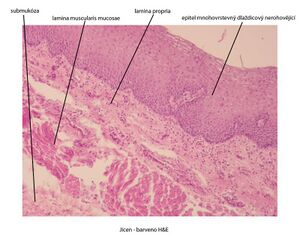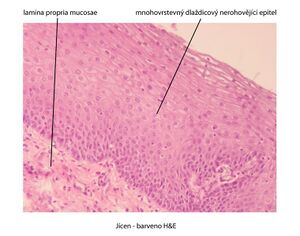Oesophagus (Anatomy and Histology)
The oesophagus is a 23-28 cm long tubular organ connecting the pharynx and stomach. It follows the pharynx at the level of the C6 vertebra, then descends through the thorax in front of the spine and ends at the level of the Th 11 vertebra at the outlet of the stomach - the ostium cardiacum. At rest, the oesophagus is about 1.5 cm in diameter and flattened antero-posteriorly. It is capable of expanding to twice its normal diameter when food is taken. In its wall we find muscular tissue which changes from skeletal (upper third of the oesophagus) to in the aboral direction. It is lined with mucosa. Its main function is the active movement of food and fluids from the mouth to the stomach. The musculature enables this active movement by peristalsis.
Anatomy of the oesophagus[edit | edit source]
The oesophagus is slightly curved. It is located in the midline at its origin, curves to the left at the neck and upper chest, passes to the right side in the middle part of the chest, curves again to the left side above the diaphragm and goes down to the ostium cardiacum. The oesophagus is divided into three parts:
- Pars cervicalis - in this part, the trachea descends in front of the oesophagus (that is why the oesophagus is shifted slightly to the left);
- pars thoracica - the longest section of the oesophagus, the trachea divides into two bronchi in front of it;
- pars abdominalis - the shortest section (1-2 cm long), from the hiatus oesophageus of the diaphragm to the ostium cardiacum of the stomach.
There are natural constrictions on the oesophagus, the distances of which are calculated from the incisors and are important for orientation during endoscopy:
- Between the cricoid cartilage and the spine - 15 cm from the incisors;
- at the level of the aortic arch- it is inconstant, 22.5 cm from the incisors,
- at the junction with the left bronchus (between it and the descending aorta) - 27,5 cm from the incisors.
- in the hiatus oesophageus of the diaphragm - 40 cm from the incisors.
The Histology of Oesophagus[edit | edit source]
The oesophagus is the muscular tube connecting the pharynx and stomach. It is composed of 4 layers typical of the general structure of the digestive tube:
- tunica mucosa (mucous membrane);
- submucosa;
- tunica muscularis externa (external musculature);
- adventitia and serosa.
Tunica mucosa[edit | edit source]
Tunica mucosa consists of:
- Superficial epithelium (multilayered squamous without cornification);
- lamina propria mucosae (sparse collagenous connective tissue, near the stomach with cardiac glands);
- lamina muscularis mucosae - smooth muscle;
- poorly detectable glands.
Submucosa[edit | edit source]
The submucosa contains fibroelastic connective tissue. Here we find groups of small mucinous glands (glandulae oesophagicae) and the autonomic Meissner's plexus (submucosal pleuxus).
Tunica muscularis externa[edit | edit source]
Tunica muscularis externa contains two layers of muscular tissue - the inner circular and the outer longitudinal. The upper third of the oesophagus is composed of striated skeletal muscle, the middle third of mixed muscle and the lower third of smooth muscle. Between the inner and outer layers of musculature is the autonomic Auerbach plexus (myenteric plexus).
Serosa and adventitia[edit | edit source]
The serosa covers only the part of the oesophagus below the diaphragm that extends into the abdominal cavity. The adventitia is the sparse connective tissue that covers the cervical and thoracic section of the oesophagus and from there it passes smoothly into the surrounding tissue and into the mediastinal connective tissue.
Histological Specimen[edit | edit source]
The oesophageal specimen is often confused with the vaginal specimen. However, the oesophagus, unlike the vagina, has a darker epithelium, contains glands, more fibroelastic connective tissue, and well-distinguishable layers of muscularis externa.
Literature[edit | edit source]
Related articles[edit | edit source]
External links[edit | edit source]
Sources[edit | edit source]
- WIKIPEDIA SK. Pažerák [online]. ©2005. The last revision 2010-05-11, [cit. 2010-04-20]. <http://sk.wikipedia.org/wiki/Pa%C5%BEer%C3%A1k>.
- JUNQUIERA, L. Carlos – CARNEIRO, José – KELLEY, Robert O. Základy histologie. 1. edition. Jinočany : H & H, 1997. 502 pp. ISBN 80-85787-37-7.
- ČEDÍKOVÁ, Miroslava. GIT II [lecture for subject histology and embryology, specialization general medicine, LFP UK]. Plzeň. -.
- LÜLLMANN-RAUCH, Renate. Histologie. - edition. Grada Publishing a.s., 2012. 556 pp. ISBN 9788024737294.




